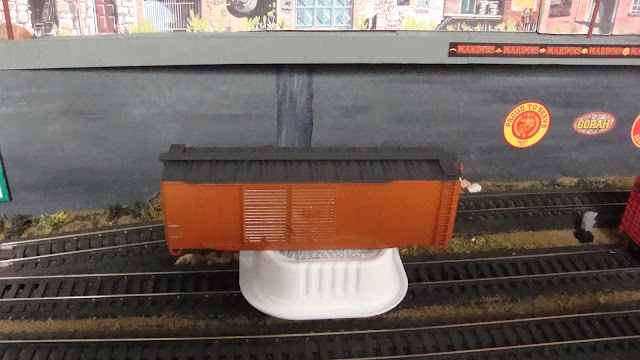Here Come The Pullmans! Several Pullman cars have arrived on the layout this past month. Let's take a look and see what models were purchased, how they'll fit into my passenger operations and some prototype information.
For those new to model railroading and prototype railroading George Mortimer Pullman, born in upstate New York in 1831 started the Pullman, Kinsey and Randolph Sleeping Car Company in 1866 to counter control of the sleeping car service in the South by the Southern Transportation Company. Well after George Pullman's death the company continued to flourish and prosper. The Pullman Company and later Pullman Standard through shrewd business dealing and maneuvers established a monopoly in the sleeping car business. Over 100 years later, in 1947, under court order the Pullman Company was sold to fifty nine railroads. An amazing story in it's own right. For more info click here
http://www.pullman-museum.org/theCompany/timeline.html
A Pullman car in NYC colors
Here is a Pullman Standard Troop Sleeper. During World War II a unique series of troop sleepers and kitchen cars based on a 50' boxcar design were rushed into service in 1943. With the end of the war in 1945 and the resulting demobilization the cars were soon declared surplus and offered for sale. Affordably priced, they required only minor modification for use as 50' boxcars. Since they were equipped for high speed passenger service they could easily be converted to other roles. Many were remodeled with plated over windows and vents, new side doors and fresh paint. In service they handled baggage, stored mail and express shipments. Many led long lives well into the late 1960s.

Here is converted Troop Sleeper, now New York Central Express Car 9503, being shoved into Empire City Station's Track 1 under the watchful eyes of Empire City's leading rail fans. The model is from the Walthers Proto line.
Next is a Pullman 8-1-2 Sleeper. In response to the public demand for more privacy Pullman unveiled the 8-1-2 Sleeper in 1927. Budget minded travelers could choose an upper or lower berth among the eight sections. For those willing to spend more, two enclosed compartments were available with upper and lower beds and their own sink and toilet. For maximum space ( and cost) a passenger could reserve the drawing room, which included all the furnishings of a compartment and a sofa. The three rooms were side by side; small doors could be opened between them to provide a suite if desired.
During the Depression many of these cars were upgraded with air conditioning to attract riders back to the rails. While lightweight stream liners caught the public's eye after World War II, production delays, declining ridership and increasing costs led many roads to repaint and remodel heavyweights to match the newer cars. Many soldiered on through t the end of passenger service and were rebuilt into M.O.W. sleepers.
This Walthers model is based on the 242 cars built to Pullman plan #3979-A between 1928 and 1930. The model represents cars modernized in the 1930s with mechanical air conditioning, some of which remained in service into the early 1960s. The model comes with a decal sheet of appropriate car names that can be added by the modeler.
Pullman 8-1-2 Sleeper car at Empire City Station.
Pullman 10-1-2 Sleeper. During the 1920 the popularity of the compartments and drawing rooms was increasing with rail passengers. Pullman and most railroads still favored open section cars which carried more passengers and generated more revenue per trip. As a result the 10-1-2 became one of Pullman's most common heavy weight cars, equipped with 10 sections, 2 compartments and a single drawing room.
Pullman 10-1-2 Sleeper at EC station. The Walthers model is based on Pullman plan #3585, Lot #4728. This car is typical of a car upgraded with A/C. Some these cars lasted into the 1960s.
The backbone of the Pullman fleet was the 12-1 Sleeper. Carrying 27 passenger for maximum profit these cars also offered the most affordable accommodations with upper and lower berths in each section. This car is based on Pullman plan 3410-A and represents a typical car updated with A/C. With other minor improvements cars of this type remained in service into the 1960s.
Pullman 12-1 Sleeper at Empire City Station.
The new Pullman Heavyweights roll into Empire City Station behind an E8A and some lightweight coaches.
Note the New York Central lightweight Pullman 4-4-2 Sleeper bringing up the markers.
Many of the Pullman heavyweights in the New York Central pool scheme were sold to the NYC in 1948 and leased back to Pullman until 1956 thru 58. At this time many of these cars appear to have been sold back to Pullman.




























